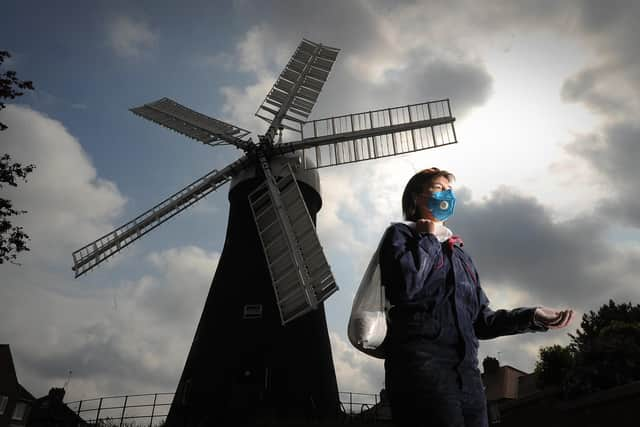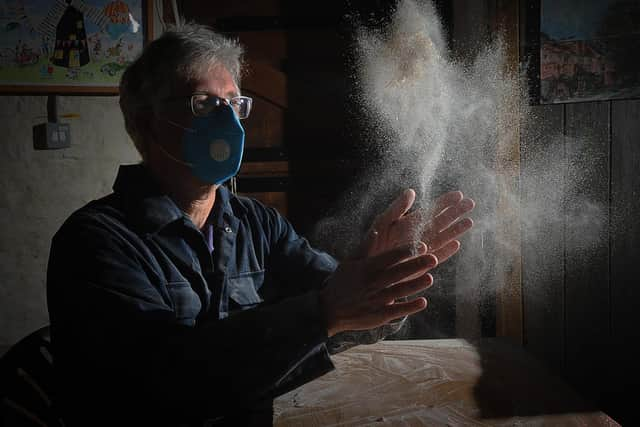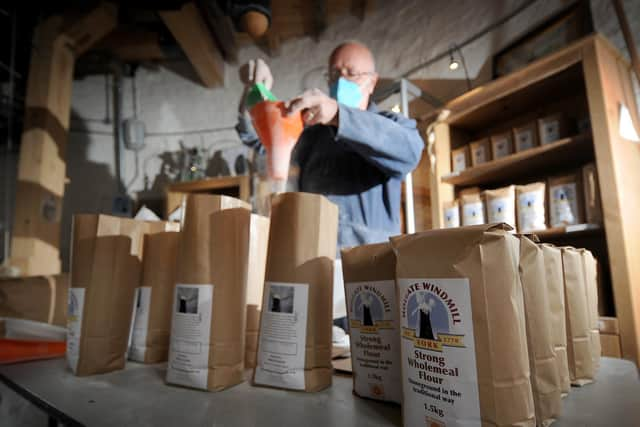Serendipity as historic mill feeds its community once again
Celebrations and events planned to mark the windmill’s 250th anniversary this year, are on hold, and will now take place in 2021.
Instead, there is a new sense of purpose beneath the soaring sails of the windmill, which has sat less than two miles outside of York city centre since 1770.
Advertisement
Hide AdAdvertisement
Hide AdExtensively refurbished after an 11-year fundraising and renovation campaign by Holgate Windmill Preservation Society, the windmill has been producing flour since its re-opening in 2012.


But on a normal week, when it is packed with school children learning about its deep history, it produces around 75kgs a week. Now, it’s milling more than 400kgs.
The preservation society’s vice chair, Helen Hoult, said: “We had so many things planned for the year to celebrate our 250th anniversary - but what we are actually doing is what the windmill was meant for - feeding our community.
“Before coronavirus we were milling quite a small amount of flour, which was enough to stock our shop and our wholesale customers, but since coronavirus, we have been in massive demand.
Advertisement
Hide AdAdvertisement
Hide Ad“We have reduced our milling team to just three people at a time, in order to comply with social distancing, but we’ve increased the days we’re milling from one day a week to four.


“We know there are shortages in the shops, and we don’t want anyone to go without.”
The society raised £500,000 for the restoration of the windmill, which is one of just 150 working windmills left in the country.
“The majority of which are heritage mills, producing small volumes,” Mrs Hoult said. “But like here, a lot have now increased production to meet demand.
Advertisement
Hide AdAdvertisement
Hide Ad“It is great to see heritage windmills come into the spotlight simply for doing what they were meant to do.”


The windmill’s shop is open just once a week, from 10am to 12pm on Saturdays, and there has been “fantastic” feedback from the queues of customers.
“We’ve definitely seen an increase in interest from wholesale customers too,” Mrs Hoult said. “We’re hoping that once people taste the Holgate Windmill flour, and realise how tasty it is, they will stick with us.
“We are getting amazing reactions. People are loving the fact that we are still working and the community feel that we have in the shop. There’s a reassurance that we are still here, and that we care for our customers.”
Advertisement
Hide AdAdvertisement
Hide AdThe mill produces two types of flour, both wholemeal: a strong bread-making flour and a spelt flour, which is an Ancient Roman flour with a “nutty” taste and texture.
“The bulk of flour in shops comes from roller mills, where big commercial rollers are used rather than millstones,” Mrs Hoult said.
Instead, the Holgate flour is produced using two large millstones, four feet six inches in diameter, between which the grain is placed and cut.
Those working in the mill are all volunteers, and wear protective equipment, including facemasks, while milling the flour.
Advertisement
Hide AdAdvertisement
Hide Ad“Our volunteers have always been brilliant, but they are showing such dedication throughout all of this.” Mrs Hoult said.
“It feels now like we are working mill, whereas before we were part-mill, part-heritage attraction.
“It is such a dark and difficult time right now, and this feels like a ray of light for us to be able to make such a positive contribution. The flour dust in the air is very evocative.”
A slice of history
Holgate Windmill was built by miller George Waud, who was born in Barlow near Selby in 1717.
Advertisement
Hide AdAdvertisement
Hide AdTwo years after buying the land where the mill now sits, which is close to Acomb, it opened, and along with his grandson he ran the mill until 1851.
It passed through several hands until it was sold to the Gutch family around 1877.
The Mill ground corn until the early 1930s using wind power, and then continued with the aid of electric motors until production stopped entirely around 1933.
The Gutch family sold the Mill to York Corporation in 1939.
Advertisement
Hide AdAdvertisement
Hide AdWhile attempts were made to restore the mill, it became neglected as a housing estate grew around it. In 2001 the Holgate Windmill Preservation Society was formed and through the dedication of its volunteers the Mill is now working once more.
Comment Guidelines
National World encourages reader discussion on our stories. User feedback, insights and back-and-forth exchanges add a rich layer of context to reporting. Please review our Community Guidelines before commenting.